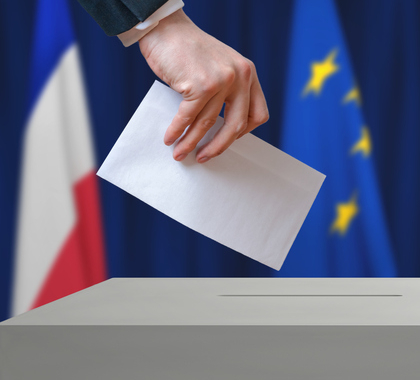In the velodrome of multi-party politics that is Round 1 in the French Presidential election system, the sprint to the finish can be exciting. This time, not so much. As expected based on pre-election polls, the social liberal, Emmanuel Macron, running as an independent, finished first, and the fiery leader of the National Front, Marine Le Pen, second.
In retrospect, these results were due to Macron’s bolting from the Socialist Party, taking its social liberal wing with him, and displacing the centrist François Bayrou. With their party rent asunder, many in the socialist wing of the Socialist Party could not resist the siren call of a true believer, and support surged for the unabashed left-wing candidate Jean-Luc Mélenchon. Going into the final weekend, four candidates – Macron, Le Pen, Mélenchon and the nominee of the center-right Les Republicans, François Fillon – were indicated to be in contention for the top two spots.
During the final days of the campaign, it is now clear, support for Le Pen waned, shifting to Nicolas Dupont-Aignan of Debout la France (“France Arise”) and other minor right-wing candidates. Debout la France is a Guallist Party or conservative party such as “conservative” applies to French politics. And, support for Macron increased at the expense of Benoît Hamon, the nominee of the Socialist Party. Thus, Macron edged Le Pen for first place.
Polls indicate that Macron will win the run-off in two weeks, in a landslide, although not by as much as Jacques Chirac beat Jean-Marie Le Pen in 2002. While out of the Presidential race, Les Republicans are looking forward to taking control of the National Assembly from the Socialists, later in the year.
The U.S. Presidential election of 2016 featured some elements in common with Round 1. The obvious similarity is that, in both, there were anti-establishment candidates of the right and of the left (Donald Trump and Bernie Sanders in the US, and Le Pen and Mélenchon in France). A second connection is the role played by multiple political parties.
During the run-up to the election, support for Gary Johnson, candidate of the Libertarian Party, ranged from 10 to 14 percent in the polls, and support for Jill Stein, candidate of the Green Party, 3 or 4 percent. Historically, support for minor-party candidates dissipates as voters shift to the more acceptable candidate of those who can actually win. Sure enough, when the votes were cast, Johnson received only 3 percent of the vote, and Stein only 1 percent. The larger shift from Johnson to Trump was perhaps the crucial reason for Trump’s amazing come from behind victory.





